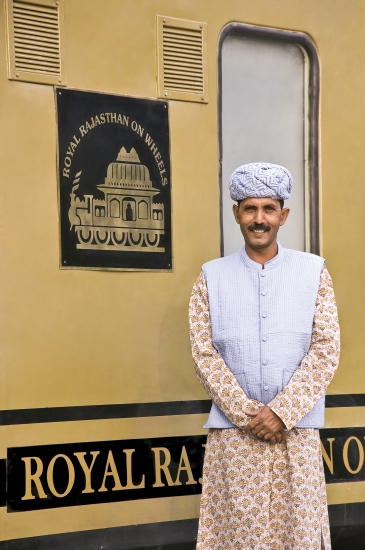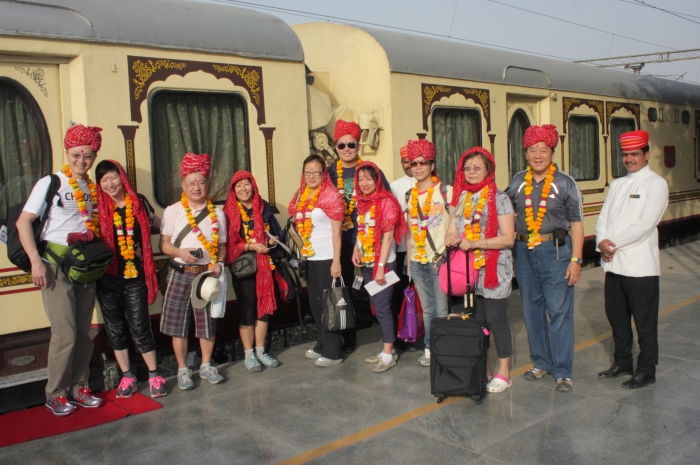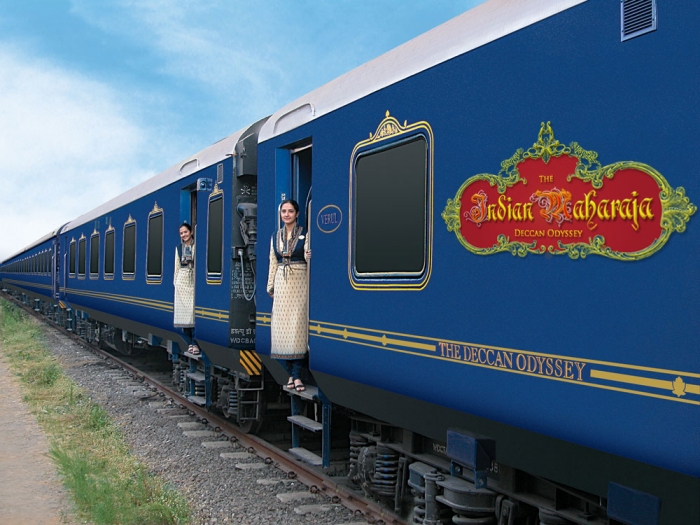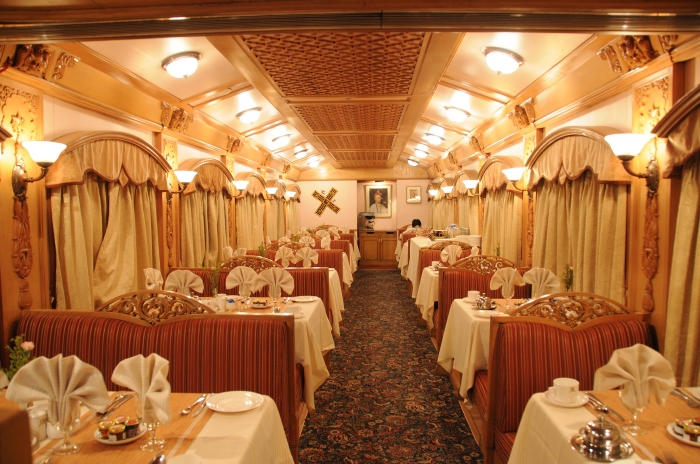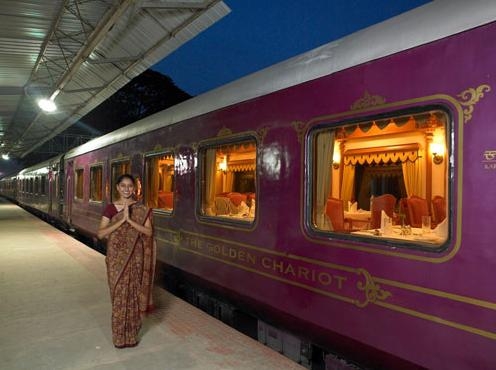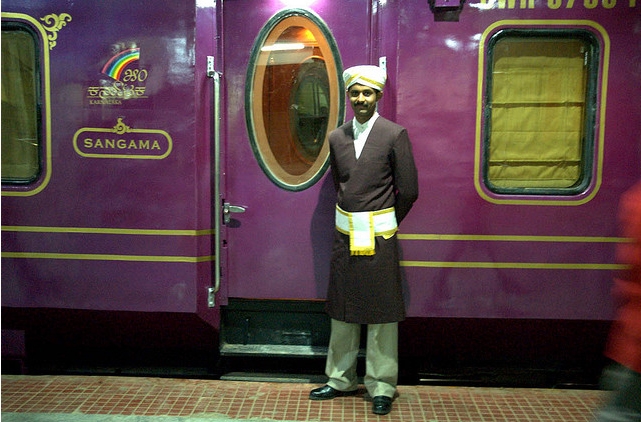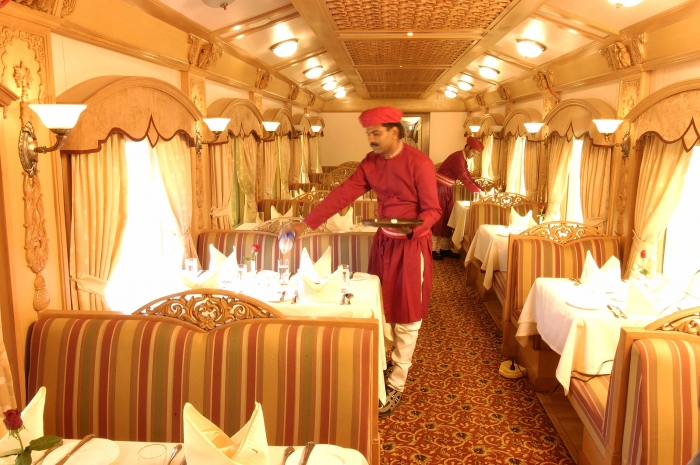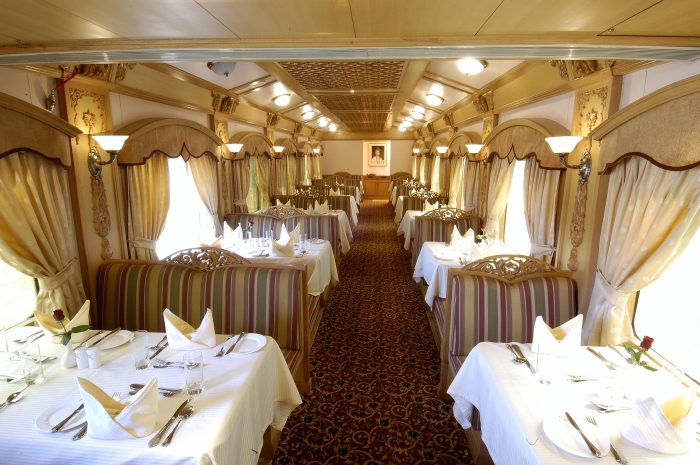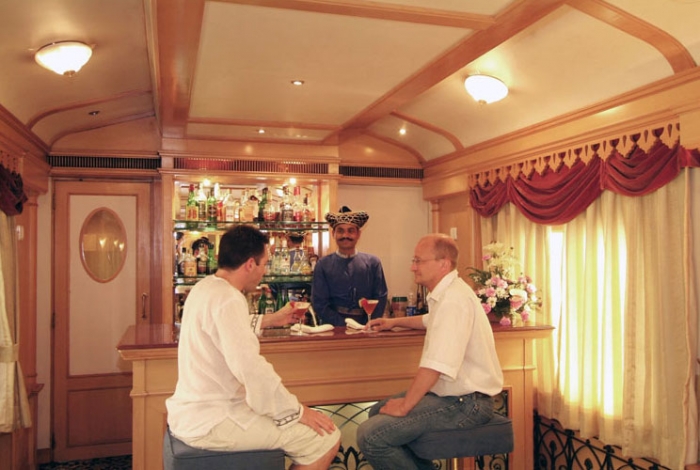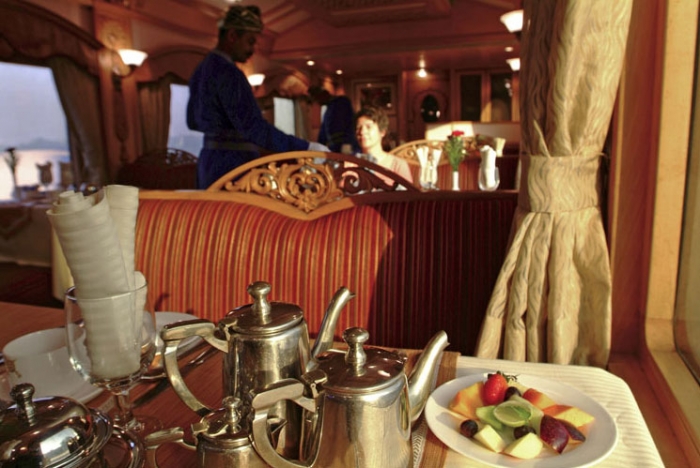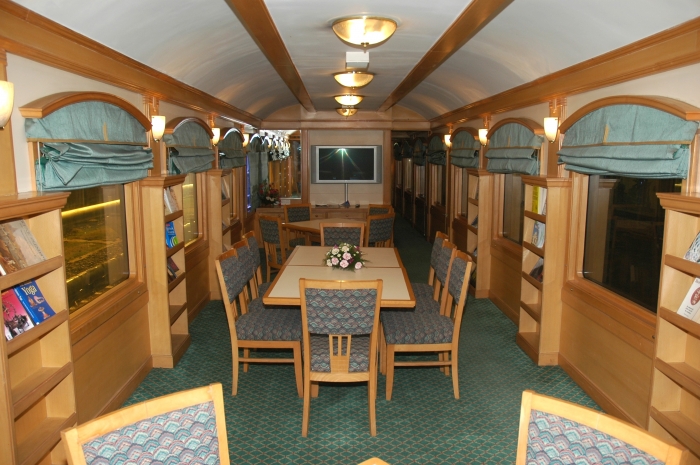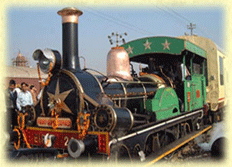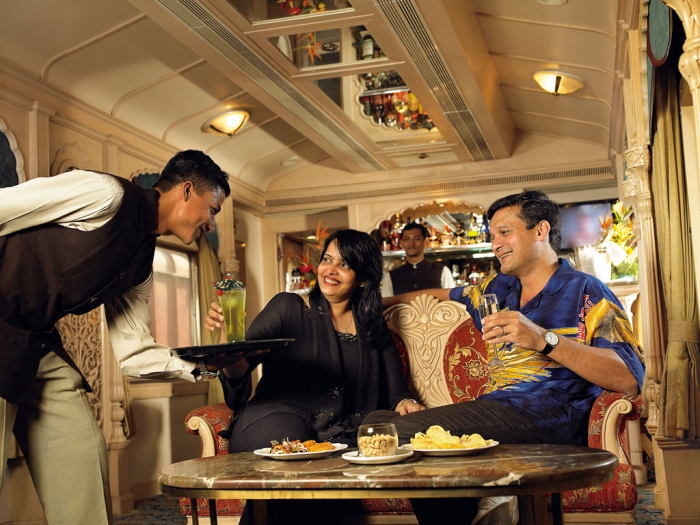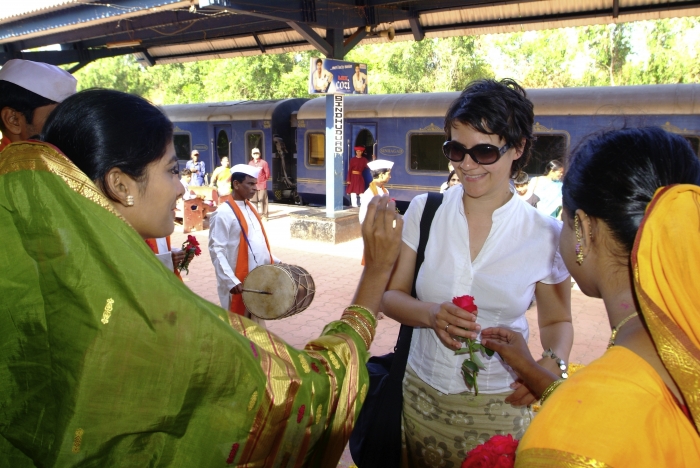|
For most of the
visitors the train system in India seem to complicated. We at Indo
Vacations are organizing train tours and would like to provide
them some information and terms with which they will be
encountered. Indo Vacations Guides and Drivers will be there to
help you however the below given matter is a kind of rough Guide
and has been collected from different sources.
A
typical long distance Indian train has the following coach
configuration: The driver and his assistant at the front
in the engine carriage. The guard is at the tail end of the
train. Trains run on
Diesel or Electric depending on the route.
There are different kind of classes and
compartment which you may also find on the tickets issued to you.
Below is an effort to explain to them.
AC 3-Tier Sleeper (3A) -
This is the air-conditioned
version of the Second Class Sleeper. Most of the express trains
have about 2 to 3 coaches of this type. More comfortable than
Second Class Sleeper and also a bit more spacious and as with all
the following increasingly more expensive classes less likely to
be rammed packed and thus much easier to relax and sleep. The
windows are tinted and do not open, so you cannot enjoy the sights
outside like in Sleeper Class - but it's easy to walk to the next
carriage and hang out the door and return when you have had enough
for the noise and heat. This is recommended if you need to travel
in a bit more comfort, especially during the summer. Bedroll
available inside the coach free of charge. Most of the facilities
are comparable with Sleeper Class.
AC 2-Tier sleeper
(2A) - Many express
trains have a couple of coaches of this class. More luxurious than
3A. You can find the well-to-do Indian class in these coaches.
This is a good asylum for those who don’t want to join the crowd
or expect luxury rather than economy. All the facilities available
in SL are available here also. Bedroll available inside the coach
free of charge.
First Class AC (1A) -
The highest luxury class on regular routes. Cost comparable with
economy class airfare. A number of important long distance trains
have these coaches. The elite class and business executives travel
by 1A. You can travel in this class for days without even having
eye contact with a co-passenger. People tend to mind their own
business (the usual stuff of newspaper reading, staring at the
laptop screen, acting sleepy etc).
AC Chair car (CC) - Generally attached to the day running
trains only. Looks more like economy class in a plane, but with a
slightly wider seat. Cost is a bit less than 3A. OK for decent day
travel. Many day running express trains have this class.
First Class (FC)
-
This is the legacy first class coach. Only a few meter gauge
express trains have them. This is first class but non-AC! Cost
between 2-Tier AC and 3-Tier AC. Spacious. You need to ask the
station manager prior to getting on the train for a bedroll.
Express Trains -
There are a number of special trains called Rajdhani (means
capital) and Shatabdi (means centenary) express. These trains have
only the luxury class coaches. And they are the fastest of all
trains in India and well worth taking. Rajdhani Expresses run
between Delhi and many important cities. Shatabdi Expresses run
between important tourist cities.
Shatabdi is a day running (no sleeping berth)
Second Class (General Compartment) - 2
to 4 coaches in a train, usually 2 just behind the engine and 2 at
the end of the train will be allocated general compartment. You'll
can make a reservation to travel in second class. or Just
buy the ticket from the counter at the railway station if seats
are still available. Second class General Compartment is one of
the cheapest ways to travel in India and perfect for a short trip
but not recommended for the
tourists from abroad as you may not be used to the
overcrowded compartments and the loud conversations and arguments
among the travellers r of many crying children. If you
manage to get a seat there is no guarantee that you can hold on to
it. You need to "reserve" the seat you occupied by keeping your
luggage or any other personal objects on the seat when you go to
toilets etc.
An empty seat is open for anyone, including you, to occupy! The
facilities are bare minimum. Food is available from vendors. 4
toilets (squat type) with water are attached to each coach. Fans
are provided. Two washbasins are also provided at both the ends.
Bring a small chain and a padlock to secure your luggage beneath a
seat or to the luggage rack.
Depending on the season,
route etc. second class coaches may get overcrowded: you can end
up breathing through your neighbour's nose! These coaches get
phenomenally overcrowded during the Indian summer season. There is
a large passenger overflow into second class from other classes
due to the overbooking of reservation seats. You can see some of
the poorer of India in these compartments. People are generally
accommodative and more than happy to talk to strangers. A
foreigner generates a lot of curiosity. You take the first step in
winning the co-passengers’ confidence. Use your commonsense to
judge the situation. An indication of their interest in you is
that you will be bombarded with questions. Be prepared to answer a
lot personal questions. The first would invariably be ‘from where
you are coming?’ ‘What is your profession?’ Then it could be how
much you earn a month. Your answers can lead to sub questions!
This is how they socialize. A poorer Indian thinks that all
western tourists are infinitely rich: they have loads of money
that they don't know what to do with. Otherwise why should they
travel around and waste a lot of money? It is surprising that even
the well-to-do class of Indian society also at times think along
this line. An average Indian is an infinitely inquisitive question
bank. Don't get offended. This is their culture. Asking such
questions is not considered impolite.
Sleeper Class (SL) - This class is the main chunk of a
typical express train. About 72 passengers are accommodated in
each coach. There are about 10 to 15 Sleeper Class coaches
attached per train. You need a prior reservation to get into them.
Reservations can be made from 60 days prior to the travel date
but may soon be extended to 90 days in advance. Seats are
made into berths in the night. The seats are grouped into sort of
semi-private sections of 6 seats, 3+3 facing each other. Upper
berth (UB), Middle berth (MB) and the Lower Berth (LB). The lower
berth is the seat for all three during daytime. The upper berth is
undisturbed and can be used for sleeping even in the daytime. The
lower berth passenger gets the window seat during the daytime.
Generally you can see a lot of co-operation among the "6 member
berth family" in berth swapping, setting the middle berth etc
during the journey. Then on the other side of the walkway there is
a row of "Side Berths". They are twin seats facing each other. If
you are more than 5.5 feet, these side berths are slightly short
for sleeping. But both of these are window seats and you will
offer little trouble for the other passengers if you want to get
out of your seat. Don't get offended if an old passenger asks to
exchange your lower berth with an upper berth.
Generally the younger
people consent to this as a courtesy to the senior passenger. Try
to avoid if possible the first and last 16 seats of the 72 seats
in each coach. These are close to the doors and toilets. You may
be annoyed by the traffic near the door and toilets, and disturbed
at night by the light. Chains are provided to secure your baggage
(bring your own padlock). Your luggage can be pushed under the
seat.
These coaches are provided with 4 toilets (1 western style, carry
your own toilet paper). The squat type is more hygienic in a
train. Using them in a moving train needs some experience. This is
a stainless steel toilet bowl with footrests set into the floor.
There are two latches for the toilet. One is a twin latch that can
be opened and closed from both inside and outside. The other can
be operated only from inside the toilet. Lock this one when you
are inside and leave the other one open. This gives the indication
from outside that it is occupied. Early mornings are a bit crowded
at the toilets. You can use the washbasin located outside the
toilet for teeth cleaning, face washing etc. The toilets are more
or less similar for all classes.
Your name is listed on a
chart stuck next to your coach's door outside. A copy is also
displayed at the departing station "Reservation Chart" notice
board about an hour before departure. These coaches are indexed as
S1,S2, S3 etc. Lookout for a square white paper label to the side
of the door with the coach number marked on it. The same is
printed on your ticket also. Most of the stations have a notice
board indicating the position of the coaches from the engine. If
this is not displayed ask any staff you see at the station for
your coach’s location. If you can find out the location of your
coach prior to the arrival of the train you can avoid madly
running up and down along the length of the train with your pack.
No bedding will be provided in this class, but without AC it is
unlikely to get too cold.
The middleclass mass of India travel by this class. Next to your
seat might be a newly married Tamil couple (who can speak
reasonably good English), an old lady (who is not very happy with
you in the beginning), her middle-aged daughter (who speaks only
Hindi) and her inquisitive young boy (who wants to know where are
you from). For a budget traveller Second Class sleeper is probably
the most suitable mode of transport.
Break Van - These are the luggage vans attached at the end
of each train. If you have any jumbo size articles (bicycle,
Motorbike, camping equipment. etc) you can carry it in the break
van of the train in which you are traveling. Luggage need not be
booked with your reservation. Just come to the boarding station a
bit earlier than the departure time and book your luggage in the
break van. The Luggage Office is located near the platform. You
need to show your ticket as proof that you are traveling in the
same train. Go personally to the break van to supervise the
loading and unloading of your luggage. This helps you to avoid any
"missing" luggage. If you are not having anything put in the
luggage van, but your luggage is more than the free allowance, you
need to pay the additional charge at this office. Typically the
free allowances are 35kg for second class, 40kg for II Sleeper &
III AC sleeper, 50kg for II AC sleeper, 70kg for I AC. About 10kg
more than this is OK. If you exceed above that, extra luggage
charges must be paid.
Pantry Car -
Most long distance trains have this facility. You can get meals,
snacks, coffee, tea (chai), cool drinks etc. Staff come to your
seat to take orders. Also you can go to the car and order
directly. You need to pay for what you buy, except on Rajdhani and
Shatabdi trains where meals are included. This is basically a
vegetarian facility with egg. Chicken curry and other meals are
available at stations for about reasonable money.
Prices are slightly higher for food than the local
restaurants. You can get decent food in an express train.
TTE -
You have to show the ticket to the TTE (Travelling Ticket
Examiner) on request. He wears a dark blazer with a name badge
over his white shirt and always carries a chart board with a huge
clip over it. You can see a beeline of passengers behind him at
boarding stations asking him questions about the status of the
waiting list. You can ask him any questions from swapping your
seat to the next coach where your friend's berth is, arrival &
departure times, which train is the best to reach Shimla, how many
children he has (it will be appreciated!) etc. If you want to
extend your journey in the same train he can do the same and give
you the receipt. He can also upgrade your class based on
availability and you can pay and get the receipt during the
journey itself.
If there is a medical emergency within the train inform the TTE.
He along with other key staffs are trained to administer first
aid. Also he can easily locate any doctors from the passenger
list. Indian railways encourage medical practitioners to prefix
their name with Dr. when booking the reservations. All the
passengers are insured by the railways against accidents within
the railways premises as per the rules. Typically a TTE is in
charge of about 4 coaches. He travels along with you. For very
long distance trains a new TTE takes charge every day. He locks
the coaches from inside during the nights. Many night running
trains have a few policemen as night guards. For any complaint or
request during your travel, approach the TTE.
Vendors - Anything is available for sale inside a train and
at stations. From safety pins to quiz books to bananas to shoe
polishing services to dried fruits - you name it! But not all of
them may be the railway’s approved vendors. A train is a big
bazaar on the move. It is part and parcel of the system. When a
train reaches a station the vendors cover the windows like bees on
the honeycomb, everyone shouting what they sell. All the services
are thoughtfully customized so that they can be easily sold
through the 4 inch gap of the window
grille! If you are sitting at the window seat, co-passengers may
request that you pass their purchases. Generally the train stops
for two minutes at a station, but at key stations it can be up to
30 minutes. A frenzy of activity (buying, selling, getting in,
getting out) takes place in two minutes before the train slowly
starts with a long whistle. Carry a bunch of coins and small
change during travel.
Reservations
- Our staff can make a reservation for you at any
of the Indian Railway reservation counters in India. There are
hundreds of them all around the country. Large cities have
counters located at multiple places for passenger convenience.
Office network of Indo Vacations at the most of the locations help
you to get the tickets booked. However we need to have you date of
Birth and complete names to secure you train ticket bookings.
Cancellations
can be done
up to 4 hours before departure of the train. Note down the
10-digit PNR and the Transaction ID. Each ticket can be for
a maximum of 6 passengers.
There is an India rail pass available for
foreign tourists which can be bought abroad. If you are not
travelling so much then it is not worth getting one.
We advice you to get the tickets booked well in
advance. This is an easy way to book tickets if you are not
curious to go to the reservation counters personally and stand in
queue. Counters are generally open 8.00am-8.00pm weekdays
and 8.00am-2.00pm on Sundays.
When searching for the availability of a particular train online
you may encounter a result like WL 40/WL 10. This may look a bit
confusing for a new user, but if you know the Indian reservation
system this is a useful bit of data. There are two kind of waiting
list for Indian trains. Seats are reserved on a first come first
served basis. Once all seats have been reserved you go into the
'Reservation against Cancellations' category popularly known as
RAC. This is nothing but a waiting list in the conventional sense.
You can still get inside a train with an RAC status ticket. You
have a confirmed seat but the berth will be allotted based on the
availability due to cancellations. After the RAC category is full,
the real waiting list (WL) comes into the picture. WL40/WL10 means
your actual waitlist position is 40th. Due to cancellation of
tickets booked before you, the current status of your waitlist is
10. In other words, 30 bookings have already been cancelled before
your enquiry/reservation (40-10=30).
Based on experience, regular travelers know how many sets normally
get cancelled on a route. It’s a bit of a chancey issue, but about
200+ seats get cancelled for a Second class sleeper per train. You
can take a chance accordingly. When you are searching for the seat
availability if you come across with something like AVAILABLE-
0068, it means 68 seats are available for the day indicated. You
will not have a seat allotted for you if the status is still under
the WL. Contact the TTE to find out your chance of getting a
berth. However you can travel with this ticket in the General
Compartment.
Thanks to all of them
who have contibuted the valuble information on this page ! |


